Sky skimmers: The race to fly satellites in the lowest orbits yet
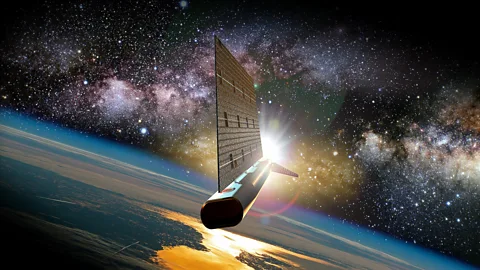 Redwire
RedwireThere's a new race in space, but it's not where you might think. It's happening close to home – in the nearest bit of space, right on the edge of Earth's atmosphere.
High in the skies of Earth, a new space race is underway. Here, just above the boundary where space begins, companies are trying to create a new class of daring satellites. Not quite high-altitude planes and not quite low-orbiting satellites, these sky skimmers are designed to race around our planet in an untapped region, with potentially huge benefits on offer.
Roughly 10,000 satellites are orbiting our planet right now, at speeds of up to 17,000mph (27,000km/h). Every one of these delicate contraptions is in constant free-fall and would drop straight back down to Earth were it not for the blistering speeds at which they travel. It's their considerable sideways momentum, perfectly stabilised against the Earth's gravitational pull downwards, that keeps satellites in orbit.
A new class of satellites is aiming to push the limits of this balancing act and plough a much more precarious, lower orbit that would skim the top of Earth's atmosphere. Known as Very Low Earth Orbit (VLEO), spacecraft at these altitudes have to battle against the significantly greater drag from the air in the upper reaches of the atmosphere than their loftier cousins, lest they get pushed out of the sky. Should they manage it, however, such satellites might achieve something even more jaw-dropping – they could potentially fly forever.
"When you start describing it to people, it starts to sound like a perpetual motion machine," says Spence Wise, senior vice-president at Redwire, an aerospace firm in Florida. A perpetual motion machine is not meant to be possible. But it almost is, in this instance.
A handful of pioneering companies have begun work on designs for satellites that may be able to orbit the planet at these unusually low altitudes while simultaneously harvesting air and using it to make propellant – literally on the fly. This new generation of orbiters could enable ultra-high-definition surveillance of activities on the ground, or superfast satellite-based communications.
If you want to send something into orbit, you have to decide how high your satellite is going to fly. Earth orbits are generally described in terms of altitude and are categorised into different sections. In high orbits, 22,000 miles (36,000km) above Earth, satellites enter a geostationary position, meaning they are always above the same location on Earth below. This is useful for telecommunications and weather monitoring, for example. Next is Medium Earth orbit, which spans from roughly 22,000 miles (36,000km) down to 1,200 miles (2,000km) above the planet's surface. Below this is Low Earth orbit, which stretches down to altitudes of 250 miles (400km), where the International Space Station (ISS) is found.
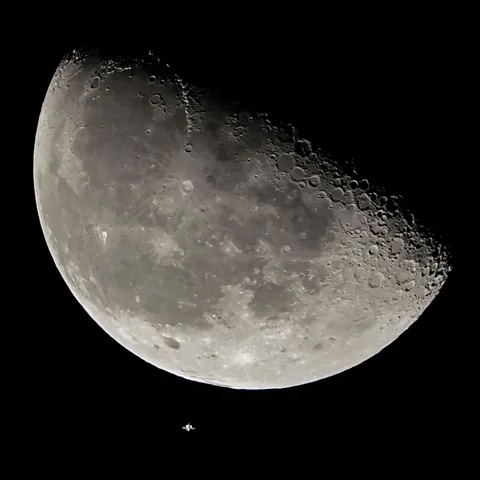 Getty Images
Getty ImagesEven further below this lies VLEO, loosely defined as anything below the ISS and down to an altitude of about 60 miles (100km). Operating here is difficult because of the influence of Earth's atmosphere. "The atmosphere will increase exponentially as you come down," says Hugh Lewis, a professor of astronautics and a space debris expert at the University of Southampton in the UK.
That creates more drag on your satellite, which can spell doom. As molecules in the atmosphere smash into the satellite, they rob the vehicle of its momentum, causing the tug of our planet's gravity to drag it towards the ground.
A satellite left in medium Earth orbit or above would carry on circling our planet for millennia. In VLEO, however, it would last barely months, weeks, or even days depending on its speed, shape and mass, dictating the amount of drag it produces and thus its lifetime. Once a satellite dips to an altitude of about 60 miles (100km), the end is imminent. The intense friction created by the thicker atmosphere subjects the satellite to temperatures of thousands of degrees, ultimately tearing it apart.
All satellites pass through VLEO on their way up or down, but not many have purposefully tried to stay there. One such spacecraft, however, was the European Space Agency's Gravity Field and Steady-State Ocean Circulation Explorer (GOCE) satellite. Launched in 2009, it orbited at an altitude of around 155 miles (250km), using an ion propulsion system to fire out charged particles behind the spacecraft. This gave it a constant level of thrust that could counteract the drag of the atmosphere.
GOCE was intended to measure Earth's gravitational field with extreme precision, which it achieved. But it also demonstrated the design choices that were necessary for operating in VLEO. It had a sleek, elongated form that helped it to overcome atmospheric drag. "It looked like a dart," says Lewis. GOCE ultimately ran out of fuel and burned up in the atmosphere on re-entry in 2013.
Several companies are now trying to do something even more impressive. They are developing technology to harvest molecules from the thin layer of air that is present in VLEO in order to actually propel satellites here. Such a system, called Air-Breathing Electric Propulsion (ABEP), has been made possible by advancements in electric and ion propulsion in recent years. In essence, it involves fixing a large bucket or opening to the front of the satellite, into which gas molecules from the atmosphere flow before they are ionised to create plasma that generates thrust.
"The idea is to use the same air slowing down your satellite as a propellant," says Francesco Romano, a scientist at the Swiss Plasma Center in Lausanne, Switzerland, who has previously studied this technology. Using electric and magnetic fields, the engine would ionise gas from the atmosphere, taking away one electron from each molecule, to produce a free electron and an ion. Then, using magnets, the electrons and ions are pushed out the back of the spacecraft, producing thrust. "Theoretically, if you can generate a thrust that is the same as your drag, you stay at this altitude for an infinite amount of time," says Romano.
To date, an assortment of experimental ABEP systems have been able to produce relatively small amounts of thrust at ground level, but their feasibility in orbit has yet to be properly tested.
One company investigating the potential of ABEP is Stellar Advanced Concepts in London. Together with another firm in the Netherlands and the University of Manchester, the company received a grant of £390,000 ($510,000) from the British government towards their efforts in July 2024. They hope to launch a demonstration of the technology into space by 2027. "That would be a small satellite with a small payload, maybe an Earth observation camera of some kind, as a proof of principle," says Mike Newsam, managing director of Stellar Advanced Concepts.
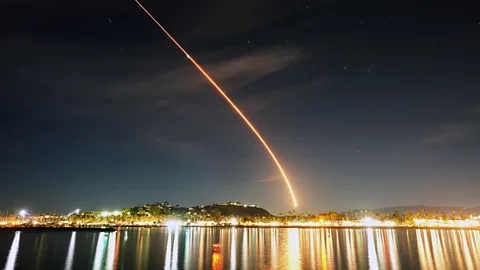 Getty Images
Getty ImagesA start-up called Kreios Space, based in Vigo, Spain, is also working on an ABEP prototype it aims to fly by 2026. In Kreios's case, this would be a small satellite "that allows us to do all the testing in orbit in different altitudes," says Adrián Senar Tejedor, the company's CEO and co-founder. The optimal altitude for thrust and drag balancing is expected to be between 125 to 155 miles (200 to 250km). "That's the sweet spot," says Senar Tejedor.
But he points out that significant contracts for developing this technology are emerging on the other side of the Atlantic.
The US Department of Defense's Otter program has already committed more than $20m (£16m) to help several companies develop air-breathing VLEO satellites. One of them, Redwire is designing a sleek "orbital drone" called SabreSat.
Redwire's design for a satellite has solar panels facing edge-on to its motion, like the fins of a fish, in order to reduce drag on the spacecraft. The company says SabreSat would be able to spend up to seven years in VLEO. The build would be modular, so that different versions of the satellite could fly with different instruments on board. "You can think of it like a ship," says Wise. "It has bulkheads, and we're able to add additional bulkheads to increase the length."
The European arm of Redwire is concurrently developing its own VLEO satellite, called Phantom, as part of a European Space Agency (Esa) project called Skimsat. "We're currently in the middle of the design stage, and the team is working towards a launch in 2027 or 2028," says Juan Pablo Ramos, business development manager for Redwire in Antwerp, Belgium.
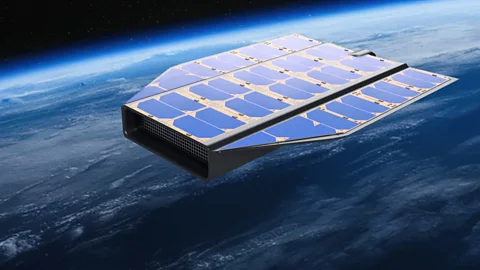 Stellar AC
Stellar ACPhantom will not use air-breathing technology, however. Instead, it will rely on a specific blend of undisclosed materials on the satellite to reduce drag and an aerodynamic cone-shaped front. "The cone is designed to improve drag and protect the instruments," says Ramos.
Getting to orbit soon is important. "I expect it to become increasingly popular," says Newsam. "I do think it's important to have first-mover advantage. Whoever gains the credibility of being able to produce an ABEP system, they would win the orders. But there should end up being a reasonably big market."
There are some very good reasons for operating a satellite in VLEO. The first is Earth imaging – the closer you are to Earth, the higher resolution your images can be. "You could either have smaller cameras and gain the same quality of data, or the same camera and get a higher resolution," adds Newsam.
That might be useful for the military, but also for civilian purposes too. "There are lots of applications in maritime, agriculture, wildfire monitoring," says Senar Tejedor. And there could be scientific benefits from studying the atmosphere in VLEO. Putting sensors on satellites operating here "would be a dream", says Sean Elvidge, an assistant professor of space environment at the University of Birmingham in the UK. "It would tell us an awful lot about the environment."
The other major application of being in VLEO is that you are closer to the ground for communications. That is particularly useful for space internet services, like SpaceX's Starlink network, which currently beams the internet to receivers on the ground from higher orbits. By using lower satellites in VLEO, the antennas can act like mobile phone towers and beam the internet straight to your phone. "Going direct to a cell phone is a challenging task to do from space," says Tim Farrar, a satellite communications expert in California. "These lower [orbits] could enable a direct-to-cell constellation."
The overall global market for VLEO satellite services could be vast. "We expect it to be around $15bn (£11.5bn) in 2032," says Senar Tejedor.
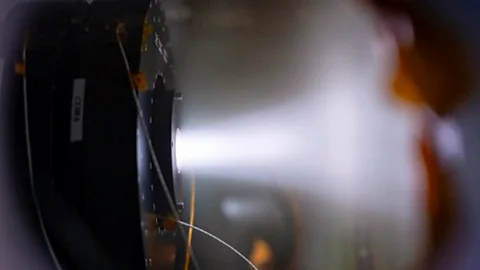 Kreios Space
Kreios SpaceAn oft-touted benefit of VLEO, aside from the various novel applications, is that this kind of orbit is self-cleaning. Generally, defunct or dead satellites in VLEO will eventually fall back into the deeper atmosphere and break up, limiting the volume of space junk that would otherwise be left orbiting Earth.
While this is true, Lewis points out that debris generated in VLEO can sometimes get flung into higher orbits, posing problems for other satellites. An Indian anti-satellite missile test in VLEO in 2019, for example, sent debris up to an altitude of 870 miles (1,400km) and it remained in orbit for 18 months, says Lewis. "If you have a collision or energetic explosion, some of those fragments can be ejected into larger orbits," he says. "It's not this perfect environment."
Having lots of new satellites potentially operating in VLEO is also going to make for a complicated environment, says Victoria Samson, chief director of space security and stability at the Secure World Foundation in Washington DC in the US. Operating in VLEO is "not a cut and dry thing", says Samson.
At such altitudes, satellites are particularly sensitive to the effects of the Sun, since heat can shrink or swell Earth's atmosphere as solar activity waxes and wanes. This caused trouble for 38 newly launched SpaceX Starlink satellites in 2022 when a geomagnetic storm caused the amount of atmospheric drag to increase by up to 50%, causing them to be pulled back towards Earth and burn up. It is a risk that will need to be carefully monitored by keeping a close eye on space weather forecasts, says Samson.
Yet there's little doubt about the rising interest in this poorly exploited region at the very edge of space. "There is a race," says Senar Tejedor. And whoever can crack VLEO first will usher in a new era of space technology.
* This article has been updated to clarify that Redwire will not achieve limitless VLEO with its SabreSat satellite under its contract with Darpa. It will be able to support a mission lifetime of up to seven years.
--
If you liked this story, sign up for The Essential List newsletter – a handpicked selection of features, videos and can't-miss news, delivered to your inbox twice a week.
